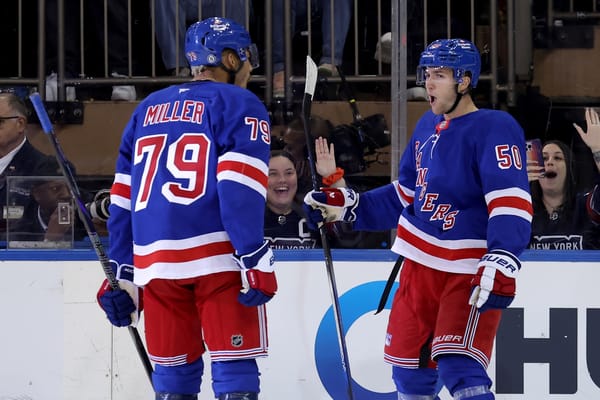A closer look at prospect Austin Rueschhoff
A big kid from Missouri
There’s a good chance that the New York Rangers were hoping they found the next Brian Boyle when they signed college free agent Austin Rueschhoff on Mar. 20, 2020.
The massive Missouri native is a towering 6-foot-7 and 230 pounds, which means that Tim Gettinger is no longer the tallest Rangers prospect. It also means that the Hartford Wolf Pack could have a center that completely changes what the team does on the power play next season, among other things.
Just as important as Rueschhoff’s height is the position he plays. He’s played center for the last three seasons at Western Michigan and the Rangers have a pressing organizational need for young centers.
The Broncos
To get a better idea of what Rueschhoff and his game is all about, let’s first talk about his team.
The WMU Broncos had an 18-13-5 record this season, which was good for the fourth-best winning percentage in the NCHC. Blues’ prospect Hugh McGing, who was also the Broncos’ captain, led the team in scoring with 35 points (13 goals, 22 assists) in 35 games. Rueschhoff finished his junior season third on the team in scoring with 12 goals and 14 assists behind Dawson DiPietro who bested him with 12 goals and 17 assists.
On paper, it looks like even strength was where the Broncos stood out from the pack in 2019-20. Per College Hockey News, WMU had a rock solid 52.7 CF% at even strength. That edge in the shot share likely had a direct hand in the team’s impressive +34 goal-differential at evens — a 60.4 ES GF%. Unfortunately for WMU, special teams was a different story.
The Broncos had the seventh-worst penalty kill in the nation (76.8%) and a 19.8 power play success rate. They also had a .905 team save percentage, which was a step below the average in D-1 in 2019-20.
This year, the Broncos were 14-4-1 in games where Rueschhoff picked up a point and 4-9-4 when he was kept out of the box score.
The Big Fella
Of course, we can’t talk about Rueschhoff without talking about his size.
The tallest forward to appear in an NHL game in the 2019-20 season was Rangers’ rookie Tim Gettinger, who Rueschhoff edges out by an inch. The last 6-foot-7 forward to play in an NHL game was former NHL All-Star John Scott who played his last NHL game on Apr. 5, 2016. So yeah, Rueschhoff is pretty damn big.
At first blush, the former Broncos center is surprisingly mobile for a player his size. He is by no means an explosive skater, but Rueschhoff’s combination of size, balance, and strength gives him the potential to be an effective puck carrier — but he undoubtedly relies on his wingspan and long stride to create separation from defenders. It’s probable that he will face a steep learning curve carrying the puck through the neutral zone and into the offensive zone in the AHL and even the ECHL. The tricks he used in the NAHL, USHL, and in the NCAA will be less effective against stronger skating defenders.
Here’s a goal that Rueschhoff scored in the USHL with the Dubuque Fighting Saints back in the 2016-17 season. After taking in his modest speed, take note of how effortlessly he uses his big frame and stride to get around the defense. The finish feels like something out of Eric Lindros’ playbook. You’ve got to love that shoulder dip.
It’s moves like this that earned Rueschhoff the attention of NHL teams before he began his collegiate career. He participated in the Toronto Maple Leafs’ prospect development camp in 2017, the St. Louis Blues’ camp in 2018, and the Columbus Blue Jackets’ camp in 2019. He turned heads with his play at all three camps, and not just because of his frame.
Here’s a more recent goal clip that shows off Rueschhoff’s tantalizing tool kit as a power forward. Big guys aren’t supposed to have hands like this.
You don’t need to watch a lot of WMU hockey games from the last few seasons to guess that Rueschhoff spent a lot of time parked in front of the net on the Broncos’ power play.
Despite his featured role on the top unit, he had a misleadingly low number of assists on the power play — seven of his 35 career helpers — because he spent most of his time taking away the opposing goalie’s eyes and didn’t touch the puck much beyond winning offensive zone draws, tipping pucks, and chasing down loose pucks with his long reach.
Front and Center
There are those who have Rueschhoff projected, at best, as a bottom-six faceoff specialist. Interestingly enough, he was the third-best faceoff man on the Broncos last year with a 52.49 percent success rate. With that said, given his quick hands and immense strength, one can imagine that he could continue to develop that skill at the next level.
It’s worth noting that he finished his freshman season in 2017-18 with a 45.7 percent success rate on the dot. And he’s done a lot more than work on faceoffs since his freshman year.
“Austin’s improvement here at Western Michigan was impressive,” said WMU head coach Andy Murray. “A quality young man, his compete level got higher each year and an increased focus on the details have led him to this NHL opportunity with the Rangers. We are excited for him and know he has a huge upside.”
Murray’s praise for his former center is particularly interesting because the big question with Rueschhoff comes down to his upside. Is there any chance he can find his scoring touch at the pro level? Or is he destined to be a role player that will sink or swim based on whether or not he can keep up with a much faster-paced game?
Much can be learned about a college prospect from their performances against the best teams in the nation. This year, Rueschhoff had one goal and 11 SOG in four appearances against the defensively dominant North Dakota Fighting Hawks (26-5-4). However, he was also one of the Broncos’ best players against the UMD Bulldogs (22-10-2), picking up three points against them on Feb. 21, 2020. He finished the season with 16 points — seven of which were goals — in his last 12 games, putting him on a collision course for a second consecutive standout performance in the NCHC Tournament.
According to Nayan Patel’s data, Rueschhoff finished second on WMU in total shot attempts (TSA) this year behind only fellow college free agent signing DiPietro. He put a lot more pucks on net in after putting his teenage years behind him with an average of 3.33 iCorsi per game (in all situations) and 2.61 SOG/GP in 2018-19 — he averaged 1.91 SOG/GP as a freshman.
That’s a significant climb in shooting, which suggests not only that Rueschhoff saw more ice time than he did as a freshman, but also that he developed the skills necessary to create separation and get shots on net.
In addition to being a featured weapon on the Broncos’ power play, Rueschhoff also killed penalties and was an important defensive forward for the team.
He stood out away from the puck at WMU because his long reach allowed him to interfere with passing lanes that other players simply can’t reach and because of his ability to take the body without making frequent trips to the box. Rueschoff is capable of absolutely rocking opposing players when he wants to, but there is a fair amount of finesse in his defensive game. With that being said, Rueschhoff definitely lacks that level of awareness that separates blue chip prospects from players who earn an NHL contract as an undrafted free agent at the age of 20.
As exciting as GIFs of his goals are, it’s clear that Rueschhoff has a lot of work to do when it comes to using his frame at the next level — and that’s okay. The bottom line with a prospect like the WMU standout is that he “only” costs the Rangers a contract spot. At the moment, it’s really hard to say what the Rangers have him in before he gets on the ice with AHL-level talent. Regardless of where his stock as a prospect is at the end of his two-year ELC, this feels like a good gamble from general manager Jeff Gorton.
The word that I keep coming back to for Rueschhoff is intriguing. Even if his ceiling is limited to a third-line grinding center, there is a lot about him as a prospect that demands a closer look. That’s why he was invited to three NHL prospect camps before the Rangers signed him and that’s why Gorton made him the second of three (so far) college free agent signings in the 2020 offseason.
All data courtesy HockeyUAnalytics.com, CollegeHockeyNews.com, CollegeHockeyInc.com, and EliteProspects.com.




